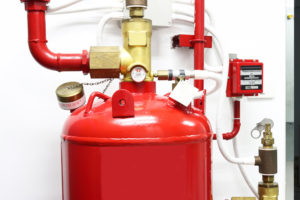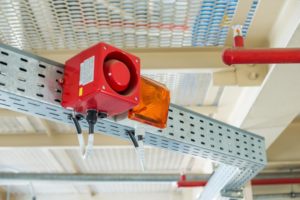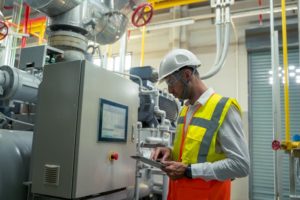Industrial fire suppression systems.
Fire suppression systems are specifically designed to protect high-risk, high-value equipment such as large machines, sensitive instruments, and power cables. Industrial plants are a high-risk environment, and industrial fire suppression systems are constructed to safely extinguish fires caused by chemicals, fuel oils, or hazardous materials. Industrial sites have unique fire suppression needs and require a fire suppression system to be carefully installed and adapted to best provide the required fire protection at power plants and other industrial sites.
Fire Extinguisher
An appropriate fire extinguisher must be approved for the type of fire hazard in the facility, maintained, and checked regularly. It is imperative to assess the fire hazard of the fuel in your facility and to ensure that your fire protection systems function correctly in the event of a fire. It is extremely important that your fire suppression systems are regularly checked and tested to ensure they work when needed in an industrial setting. Do not put your employees, property, or inventory at risk.
Fire Alarm System
Fire alarm systems are intelligent addressable systems specially designed to meet your needs, anything from flame, smoke, aspiration, heat, linear heat, or gas detection. It is essential to regularly inspect your system to ensure it is working correctly and meets proper standards.
Sprinkler System
A sprinkler system is a pressurized water piping system with sprinkler nozzles. The sprinkler nozzles will release pressure when exposed to fire/heat, and the water will immediately spray out under pressure to extinguish the fire.
Sprinkler systems are constantly being filled with water, so if the triggered sprinkler catches fire, the water will immediately flow out under pressure in the hose. The detection system requires water to flow quickly and freely to extinguish the fire after entering the piping system.
Traditional water sprinklers can do as much damage to a building or critical resources as a fire itself. For environments such as these, or those containing production equipment or irreplaceable assets such as paintings, wet sprinklers are not the best solution to extinguish a fire. Sprinkler fire suppression systems may seem like the perfect option for putting out a fire, but when it comes to fires in rooms with computers, electronics, and other valuables, you don’t have to choose between fire and water, choose a gas system.
Water mist systems can be connected to a building’s water supply for continuous fire suppression, or in remote areas, they can be connected to a tank or reservoir. For example, water mist is most effective in suppressing the fire hazard of Class B fluids associated with lubricating components, turbine shafts, and diesel generators.
Gas System
Water-based and inert gas systems are the most environmentally friendly options because water and inert gas are natural substances extracted from the environment and used for firefighting. There are systems for electrostatic painting, flammable liquids, computer rooms, ovens, turbo generators, power plants, or aircraft hangars.
Passive fire protection
Fire Security offers passive cable fire protection utilizing cable coating, which can supplement and sometimes even replace fire suppression systems. A significant advantage of our cable protection approach is low cost and no need for maintenance.
Our fire coated cables remain in service during a fire ensuring circuit integrity of emergency services and electrical systems. The coated cables do not need to be replaced after the fire.




